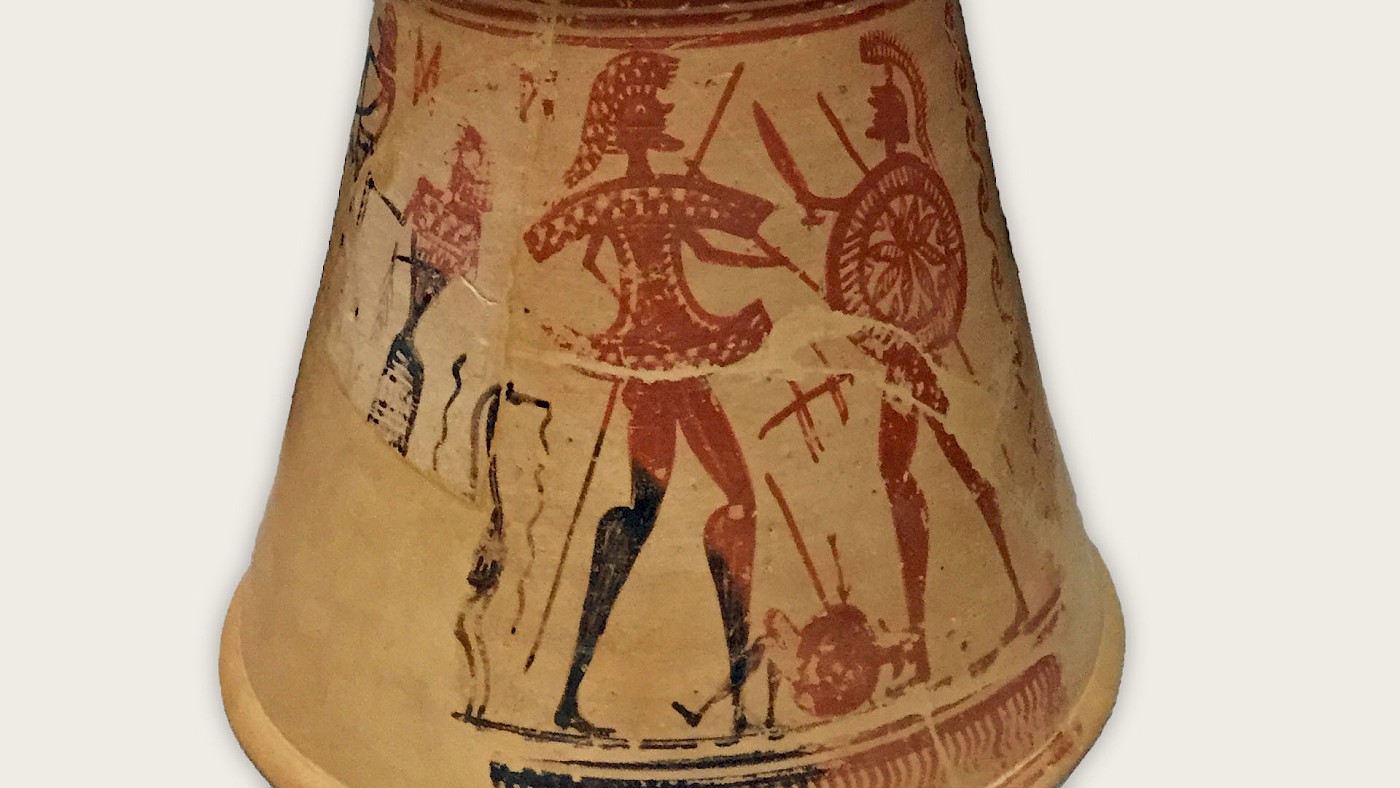The Antikensammlung in Munich, one of several museums in the city dedicated to the ancient world, has a Greek stand dated to ca. 710 BC that depicts a battle scene. A detail of the stand is used as this article’s featured image, above. The museum sadly doesn’t give a provenance for this stand (inv. no. NI 8936), but it’s likely Attic in origin.
The date is no doubt based on the grounds of style: the figures are rendered in outline, comparable to the Geometric style of vase-painting of especially the eighth century BC. The details added to the clothes and equipment of the human figures anticipates developments characteristic of the Proto-Attic style of vase-painting of the seventh century BC. A date somewhere in the late eighth century BC seems reasonable.
This stand has been reconstructed from various sherds and pieces are missing. A female figure can be seen to the left of the two warriors and she seems to hold shafts of wheat in one of her hands; perhaps she is to be identified as the goddess Demeter?
In between this woman and one of the warriors we can see a diminutive horse: did the warrior arrive on horseback or is this horse part of a team yoked to a chariot? Again, we cannot tell for sure.
Locked in combat
What we can say for sure is that the two warriors are locked in combat. Both of them are equipped with shields and helmets. The figure on the left has a shield with scallops cut out from the side (a variation on the so-called Dipylon-type shield so familiar from Geometric painted scenes). The figure on the right is equipped with a round shield with rim; perhaps an Argive shield, typical of later “hoplites”?
Both figures have helmets with crests, though the one on the right has a crest raised on a stilt. They both carry a spear in their shield-hand: the figure on the left stabs with another spear, while his opponent brandishes a sword. The type of sword, even in this stylized form, can be recognized as a so-called Naue-II-type blade.
Beneath the two warriors, on the ground, is a much smaller warrior, still cluthing his round shield, but apparently pierced by a spear and a smaller arrow. The scene as a whole is what in German scholarship is referred to as a Leichekampf (“corpse battle”). Scenes like this are common in Greek art. Their appeal isn’t surprising: two warriors fighting over the corpse of a third instantly tells a story of victory and loss.
Such scenes are important not only in the figurative arts. Much of the fighting in the Iliad takes place around the corpses of the fallen. During these Leichekämpfe, friends try to drag the body of their fallen comrade back behind their own lines, while the enemy attempts to strip the corpse of its armour and despoil the body (Il. 4.466, 506, 532; 5.164, 435; 6.28, 71; 7.77–80; and so on). At one point, Hektor and Aineias chase off a number of young Achaian warriors. The poet adds that “Many fine pieces of armour littered the ground on both sides of the ditch, as the Danaans fled” (Il. 17.760–761; transl. Lattimore). Enemy horses and chariots were also appropriated where possible (for example, Il. 5.165).
Such scenes generate sympathy for the fallen, while giving allies and enemies alike a chance to win glory in battle over possession of the corpse (and its equipment). Such battles are not limited solely to art and poetry: they also crop up in the work of the ancient Greek writer Herodotus, though arguably the descriptions are heavily influenced by epic poetry.
A famous example can be found in his account of the Battle of Thermopylae in 480 BC. After several days of hard fighting, the Spartan king Leonidas was killed, alongside other brave Spartans. An epic battle ensued over the corpse of Leonidas that is more than just a bit reminiscent of the Leichekämpfe from Homeric epic (Hdt. 7.224-225).
In later authors, such battles are rarely mentioned, though it seems natural to assume that warriors would have tried to protect their comrades in battle, even if the latter had been slain. And even today, some elite military groups, such as the US Navy SEALs, proclaim never to leave anyone behind.
A significant scene
There’s no telling if the stand was made to commemorate a particular battle or if it is supposed to depict a scene from myth. Perhaps it simply represents some kind of ideal type: the warriors fighting for control of a fallen warrior, whether friend or foe.
The presence of a possible goddess hints that this might be a scene based on myth, but, again, we can’t be sure. Still, objects usually are important to their owners. The scene must have been significant to whoever commissioned or otherwise obtained this stand.
Further reading
- Gudrun Ahlberg, Fighting on Land and Sea in Greek Geometric Art (1971).
- Deborah Boedeker, “Epic heritage and mythical patterns in Herodotus”, in: E.J. Bakker, Irene J.F. de Jong, Hans van Wees (eds), Companion to Herodotus (2002), pp. 97–116.
- Josho Brouwers, Henchmen of Ares: Warriors and Warfare in Early Greece (2013).
- Anthony Snodgrass, Homer and the Artists: Text and Picture in Early Greek Art (1998).
